Did Vikings find their way to a remote part of Oklahoma? Some in a small community believe so, thanks to controversial runic carvings found in the area
“[Farley] spent the majority of her adult life researching the stone,” said Amanda Garcia, Heavener Runestone Park manager. “She travelled all around the US, went to Egypt and went to different places looking at different markings”
Faith Rogers, an environmental-science intern and volunteer at the Heavener Runestone Park, led me down a cobblestone path toward one of the 55-acre woodland’s biggest attractions – which is also one of the US’ biggest historical mysteries. We were deep in the rolling, scrub-forest foothills of the Ouachita Mountains in far eastern Oklahoma, and we were on our way to view a slab of ancient sandstone that still has experts scratching their heads and debating about the eight symbols engraved on its face
Some believe that these cryptic inscriptions are runes (ancient alphabetical characters) carved into the towering stone circa 1000 CE by Norse explorers who travelled up the Arkansas River to this remote part of landlocked America
“Do I think the Vikings carved this? I do,” said Rogers, as we stood in the protective wood-and-glass “house” built around the 3m-by-3.6m slab. “[Local historian] Gloria Farley spent her whole life researching this, and she has a lot of evidence to back it up”
Farley – who grew up in the town of Heavener where the runestone was found and who passed away in 2006 – is a legend in these parts. She first saw the relic while hiking as a young girl in 1928 and was fascinated by it. Two decades later, she returned to study it, as an amateur runologist and self-taught epigraphist
The first modern knowledge of the runestone dates to the 1830s, when it was found by a Choctaw hunting party. For years, white Oklahomans called it Indian Rock, mistakenly thinking that the carvings were Native American
“[Farley] spent the majority of her adult life researching the stone,” said Amanda Garcia, Heavener Runestone Park manager. “She travelled all around the US, went to Egypt and went to different places looking at different markings”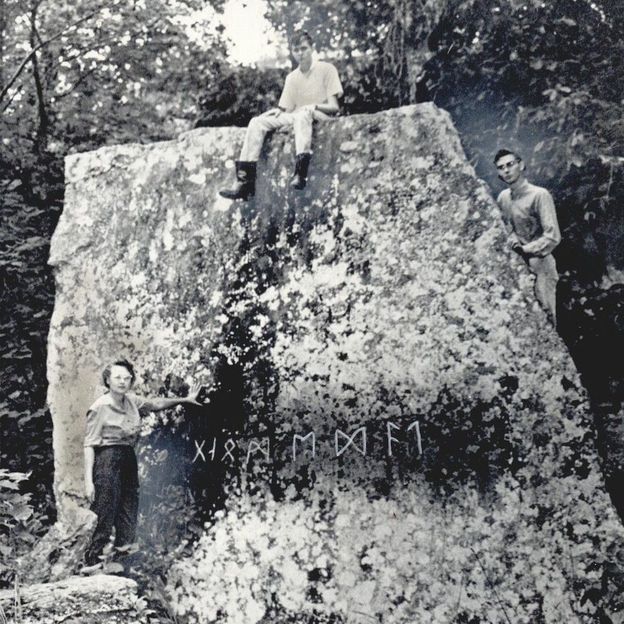
Gloria Farley first saw the Heavener Runestone while hiking as a young girl in 1928; here, she is with her sons in 1971 (Credit: Courtesy of the Oklahoma Historical Society)
She even contacted the Smithsonian only to find that they’d already made their conclusion back in 1923: they said the characters were of a Scandinavian language, and read “GNOMEDAL,” or “gnome” and “dal”, translated as “sundial valley” or “monument valley”. Other scholars afterwards translated the symbols as “GLOMEDAL,” meaning “Glome’s Valley.” So that cleared up the question of what language it was, but left two other questions unanswered: who carved those symbols, and when
“I began to believe that the symbols on the stone indicated that Norsemen had visited the area before the time of [Christopher] Columbus. I renamed the rock ‘The Heavener Runestone’ and began my search for similar inscriptions in the area,” Farley wrote in her book In Plain Sight: Old World Records in Ancient America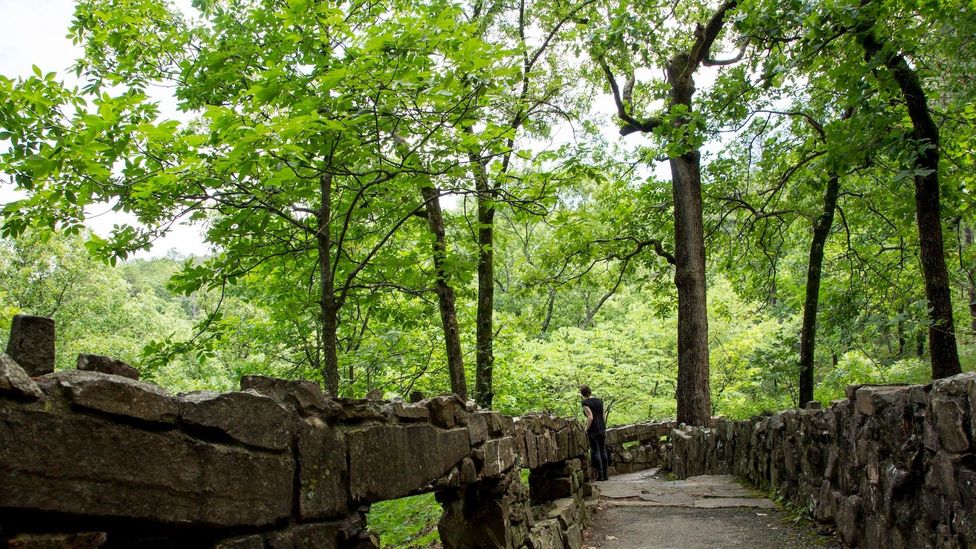
Heavener Runestone Park is in the foothills of the Ouachita Mountains in far eastern Oklahoma (Credit: Oklahoma Tourism & Recreation Department)
Throughout her career, Farley consulted with Norse historians, geologists and other epigraphists. She gathered evidence that supported her claim that Vikings had visited North America and were more than capable of travelling up rivers and creeks in longboats that could float in shallow water
“A study of the fascinating Norse sagas revealed the efforts of the Norse inhabitants of Greenland to colonise the eastern coast of America from approximately 1002 until 1010 [CE],” she wrote. “If the Vikings had sailed to Russia, Ireland, England, France and to the far end of the Mediterranean, why would it have been impossible for them to reach Oklahoma via the Mississippi River”
Ultimately, Farley led the charge that Vikings sailed inland from the Gulf of Mexico 600 to 800 years ago and left their mark in this canyon. Two additional sandstone slabs, each with runic markings (not enough to be translated), were found a mile north and a mile south of the Heavener Runestone, which park officials say indicates that the carvings were boundary markers
The idea of Vikings cruising the mighty Mississippi isn’t as far-fetched as it might seem
The idea of Vikings cruising the mighty Mississippi isn’t as far-fetched as it might seem. Reported Viking runestones have been found in other places throughout North America (including in Kensington, Minnesota, and Spirit Pond in Maine), and Oklahoma itself has unearthed six, the most of any state in the US, though their authenticity is still in question
However, one Norse settlement – L’Anse aux Meadows, a Unesco World Heritage Site on the northernmost tip of the island of Newfoundland, Canada – has been proven to date to at least 1021 CE, thereby providing a concrete timeframe for Viking activity in North America, and one that coincides with the estimated age of the Heavener Runestone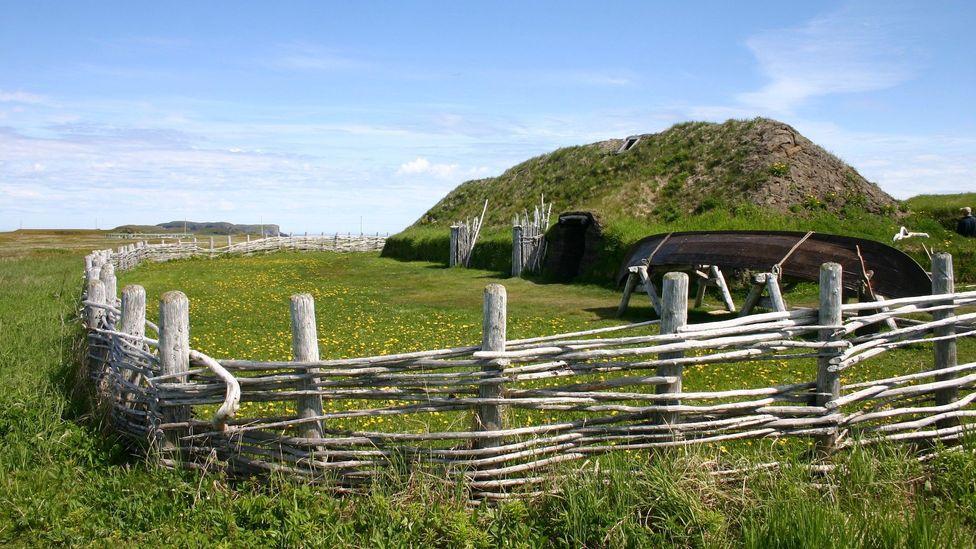
The Norse settlement of L’Anse aux Meadows in Newfoundland dates to at least 1021 CE, providing a timeframe for Viking activity in North America (Credit: Murphy_Shewchuk/Getty)
According to Farley, Vikings could have easily travelled south from Newfoundland along North America’s eastern seaboard, then swung around the tip of Florida to the Gulf of Mexico where they could enter the Mississippi River, which flowed into to the Arkansas River, which in turn led into the Poteau River in Oklahoma
“The Poteau River is just a few miles from here,” said Garcia. “Don’t think about how the waterways look now. Before all [the] man-made lakes and dams, these little creeks were big rivers and waterways back then”
Not everyone is convinced though. In 2011, Lyle Tompsen, an archaeologist who specialises in the Viking era, analysed the runestone and wrote a paper concluding: “The veracity of the Heavener stone as a Viking artifact is problematic. The linguistic evidence is ambiguous. However, historical evidence from the 19th Century… strongly suggests the stone is a 19th-Century creation of a Scandinavian immigrant (likely a Swedish immigrant working at the local train depot)”
Other theories are floating around. One is that the stone was carved by a member of the La Salle expedition circa 1687, when French explorer René-Robert Cavelier claimed the area (which he named Louisiana) for France. Yet another is that it’s the work of a Swedish captain who led German colonists to the area between 1718 and 1720
The language of the runes remains in question too. “The inscriptions are not a Viking script, but a combination of [runic languages] Elder Futhark and Younger Futhark, which predates when the Vikings would have been traveling,” said Dennis Peterson, archaeologist and manager of the Spiro Mounds Archaeological Center, the source of America’s largest collection of prehistoric Native American relics, not far from Heavener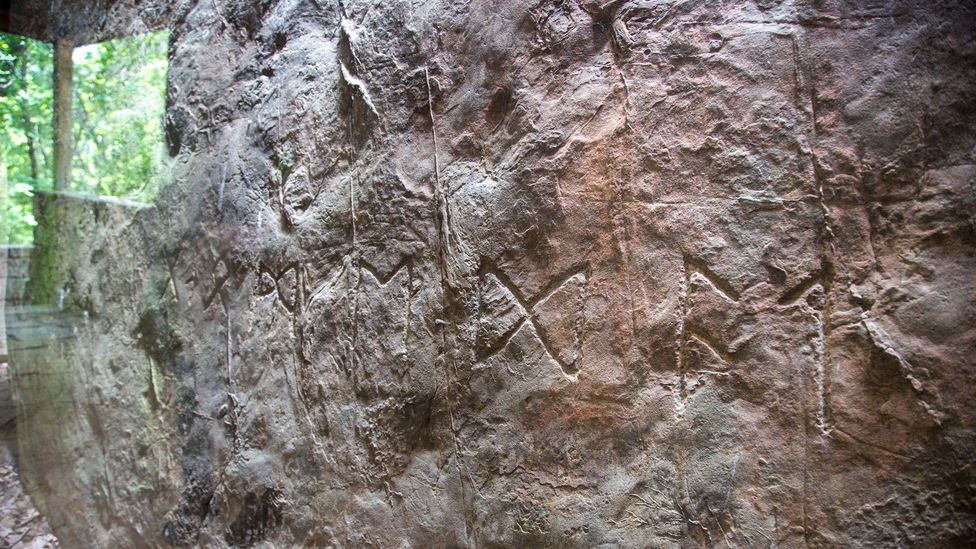
The Smithsonian determined the runes were of a Scandinavian language and translated as “sundial valley” or “monument valley” (Credit: Oklahoma Tourism & Recreation Department)
“But they’re also potentially more recent than that too, because the same style of writing was being taught in Northern Europe in the 1800s, much like when we used to have to learn Latin or Greek. So, it’s a higher probability that somebody who learned Elder Futhark in school came through and left the equivalent of graffiti”
Peterson also argued that because Spiro was a major trading metropolis during the same era, some record would have been left behind of strange Nordic men coming through the area
Because carvings made in stone can’t be dated using traditional scientific methods (such as carbon dating or comparing the decay rate of organic materials), researchers of the Heavener Runestone have had to look to contextual evidence, such as additional Viking artefacts or activity in the area; however, none has been found. “There’s simply not a lot of evidence pointing to Vikings coming into Oklahoma,” said Larry O’Dell, director of the Oklahoma Historical Society
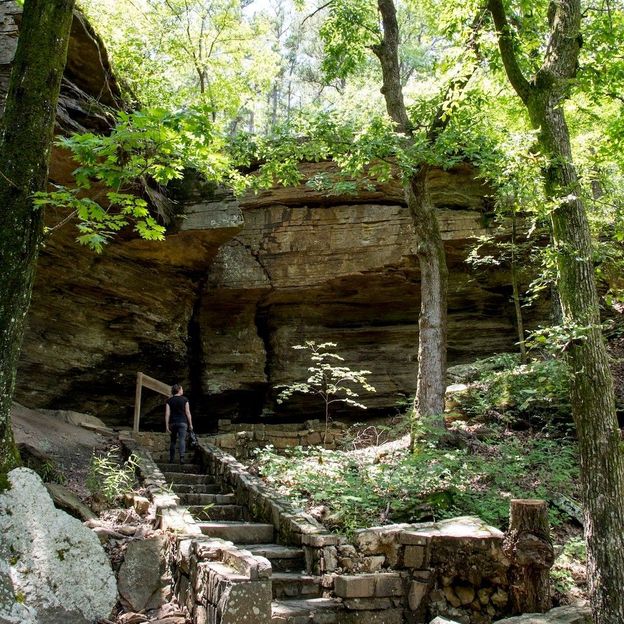
Fans of Viking lore come from all over the world to visit Heavener Runestone Park (Credit: Oklahoma Tourism & Recreation Department)
Despite that dubiousness, fans of Viking lore come from all over the world to visit Heavener Runestone Park. “We had a gentleman from Austria, and his sole purpose to come to the US was to see the runestone,” said Garcia. “When I first started here five years ago, we had around 400 people a month; now we have that many in a week. Depending on different times of the year, we could have 2,000 people or more on a regular weekend”
The park even hosted a Runestone Viking Festival for 10 years that attracted thousands of visitors, reenactors and Scandinavian vendors in the past. In fact, the festival got so big that it’s currently on hiatus while organisers figure out how to accommodate the crowds
Standing eye to eye with those ancient letters, I, too, wanted to believe in the legend of Vikings sailing into Oklahoma, and I left the park with visions of bearded warriors striding through the same boulder-strewn forests and dense woodlands I was exploring. No evidence may prove that they definitively did, but no evidence proves that they definitively didn’t either
stories from BBC Future, Culture, Worklife and Travel